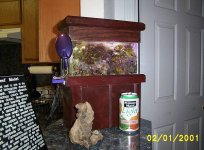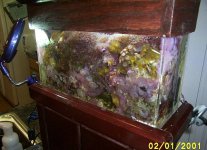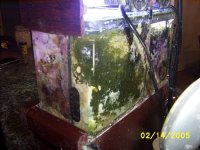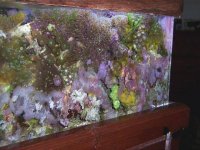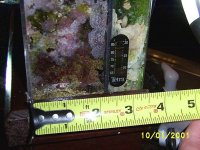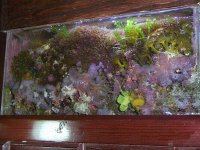For some reason this Kodak will not capture the electric green of the GSP, it just has some sort of drab cast over the pic when compared to a live view. I have friends at work with a penchant for digital photography, I'm sure one of them will come over to snap a pic group for me and that's what I'll use in the layout. I once called some assorted photography pros in the phonebook, but none would come out for less than $75-100 which is likely the only justified use of their time. I tell you that Antoine's cool pix submissions have sure made me consider that setup, wow on the macro pics!
One of the aquscaping challenges of this system involves careful consideration of full polyp expansion, the affect on neighboring corals, and planning for long-term growth. I don't enjoy keeping pico reefs that are any more demanding than larger setups, the primary challenge is to make a 'palmtop reef' run with the same consistency as a 5+g setup and that is an ongoing challenge.
The GSP wasn't always so dense in this aquascape, but it has taken the better part of a year to get this prominent--an acceptable growth rate for me. A coral banded shrimp (tiny juvenile) combs the reef at night picking detritus and various tissues for cleanliness. At any time I could have used 'stats to pull the GSP back and prune, but I have decided to let it take over my central m. digitata colony as a demonstration of proximal warfare. Both were cultured colonies cloned by fragmentation 50 times over, so I see it much like feeder fish and oscars. Is it really required for survival in the captive aquarium? No, however it is an interesting element of reef life I can re-create without any impact to either species. It's nice to be in a branch of the marine hobby where that can be said...
It is most interesting to see the ways coralline algae and GSP have conformed to the reef face over time to seal it together, and over take all but an eraser-sized area of brown montipora tip growth (still visible in closeup pic near hammer coral). I'm going to keep it in check away from my pagoda and euphyllias (on the left side of the reef, with supplemental palm light)
Dealing with small LPS heads that can have sweepers is particularly challenging in a 1/2 gallon reef. A critical method for me is to have a directional flow of water from the powerhead, that always keeps them flowing in one direction. With that assurance I can plant a candy coral group right alongside a hammer coral and rest assured they'll never touch. They are 1/2" apart in the photgraph below. I also use in certain places small clips of curved plastic as polyp blockers, cut out from one of my daughter's barnie doll packages and about the size of a quarter with one edge curled up...glued in place just under the frag. There is one in the upper left hand corner of the reef face protecting a pagoda frag (size of a quarter) from the frogspawn below it. The neatest effect is the plastic goes almost 100% clear underwater, making it nearly invisible. When they become opaque from reef deposition they are easy to replace.
These pics were taken at night and some of the corals are withdrawn for the night phase (beatings from the boxer shrimp who is really just thoroughly hunting for food) namely the frogspawn and the hammer corals. I have tried to mimic the structure of a full-blown reef aquarium by using smaller chunks of live rock and calcified oyster shells as the reef slope, rather than large inserts that take up too much space. The key in getting this look is not using frags that take up any more of a % viewing area than that same larger colony would take up in a 120 gallon reef.
For example: When you look at the front pane of glass on a 120 reef, a given blastomussa colony may only take up 35-55 square inches in the field of view. It does not consume 1/3 of the total viewing area, so if we were to try to mimic the natural presence of this colony in a pico reef face one should only use a group of polyps that consume a nickel or quarter-sized fragment to remain in scale. The scaling doesn't have to be exact; it is an attempt to mimic and that is sufficient when you repeat the process for 20 individual frag placements. Shop for tiny polyps, I have seen the same species blastomussa come in eraser-sized polyps or half-dollar size--depending on the age of the colony, its origins and growth conditions during maturation.
The blurry rear shot is an internal refugium that is a source of balance for the system. it has chaetomorpha and grape racemosa. I meant it it work hand-in-hand with the top pane of glass as an evaporation-restriction system, with built in 02 pump. I also attribute my algal cleanliness to the heavy uptake of the refugium, I prune a full handfull of macroalgae 1-2 times a month. it is crawling with copepods and may also be a source of nutrition for the system.
I hoped to create a false wall effect when viewed from the front... the best possible scenario is for it to not look like a 2-inch thick reef wall when seen from the frontal shot. The system is about 3.5 inches front-to-back, one for the refuge and 2 for the coral real estate.
One of the aquscaping challenges of this system involves careful consideration of full polyp expansion, the affect on neighboring corals, and planning for long-term growth. I don't enjoy keeping pico reefs that are any more demanding than larger setups, the primary challenge is to make a 'palmtop reef' run with the same consistency as a 5+g setup and that is an ongoing challenge.
The GSP wasn't always so dense in this aquascape, but it has taken the better part of a year to get this prominent--an acceptable growth rate for me. A coral banded shrimp (tiny juvenile) combs the reef at night picking detritus and various tissues for cleanliness. At any time I could have used 'stats to pull the GSP back and prune, but I have decided to let it take over my central m. digitata colony as a demonstration of proximal warfare. Both were cultured colonies cloned by fragmentation 50 times over, so I see it much like feeder fish and oscars. Is it really required for survival in the captive aquarium? No, however it is an interesting element of reef life I can re-create without any impact to either species. It's nice to be in a branch of the marine hobby where that can be said...
It is most interesting to see the ways coralline algae and GSP have conformed to the reef face over time to seal it together, and over take all but an eraser-sized area of brown montipora tip growth (still visible in closeup pic near hammer coral). I'm going to keep it in check away from my pagoda and euphyllias (on the left side of the reef, with supplemental palm light)
Dealing with small LPS heads that can have sweepers is particularly challenging in a 1/2 gallon reef. A critical method for me is to have a directional flow of water from the powerhead, that always keeps them flowing in one direction. With that assurance I can plant a candy coral group right alongside a hammer coral and rest assured they'll never touch. They are 1/2" apart in the photgraph below. I also use in certain places small clips of curved plastic as polyp blockers, cut out from one of my daughter's barnie doll packages and about the size of a quarter with one edge curled up...glued in place just under the frag. There is one in the upper left hand corner of the reef face protecting a pagoda frag (size of a quarter) from the frogspawn below it. The neatest effect is the plastic goes almost 100% clear underwater, making it nearly invisible. When they become opaque from reef deposition they are easy to replace.
These pics were taken at night and some of the corals are withdrawn for the night phase (beatings from the boxer shrimp who is really just thoroughly hunting for food) namely the frogspawn and the hammer corals. I have tried to mimic the structure of a full-blown reef aquarium by using smaller chunks of live rock and calcified oyster shells as the reef slope, rather than large inserts that take up too much space. The key in getting this look is not using frags that take up any more of a % viewing area than that same larger colony would take up in a 120 gallon reef.
For example: When you look at the front pane of glass on a 120 reef, a given blastomussa colony may only take up 35-55 square inches in the field of view. It does not consume 1/3 of the total viewing area, so if we were to try to mimic the natural presence of this colony in a pico reef face one should only use a group of polyps that consume a nickel or quarter-sized fragment to remain in scale. The scaling doesn't have to be exact; it is an attempt to mimic and that is sufficient when you repeat the process for 20 individual frag placements. Shop for tiny polyps, I have seen the same species blastomussa come in eraser-sized polyps or half-dollar size--depending on the age of the colony, its origins and growth conditions during maturation.
The blurry rear shot is an internal refugium that is a source of balance for the system. it has chaetomorpha and grape racemosa. I meant it it work hand-in-hand with the top pane of glass as an evaporation-restriction system, with built in 02 pump. I also attribute my algal cleanliness to the heavy uptake of the refugium, I prune a full handfull of macroalgae 1-2 times a month. it is crawling with copepods and may also be a source of nutrition for the system.
I hoped to create a false wall effect when viewed from the front... the best possible scenario is for it to not look like a 2-inch thick reef wall when seen from the frontal shot. The system is about 3.5 inches front-to-back, one for the refuge and 2 for the coral real estate.




